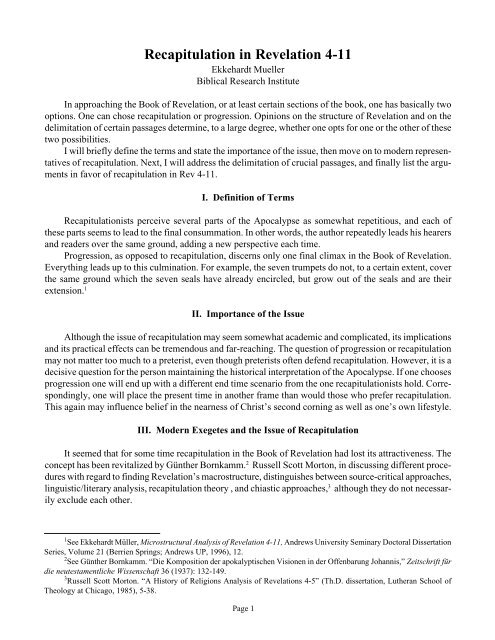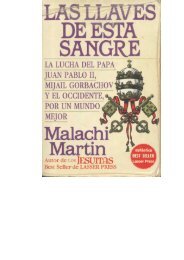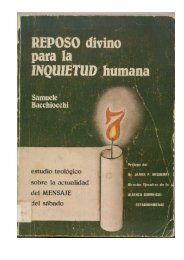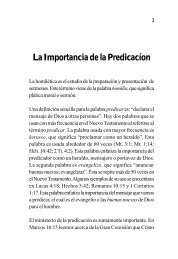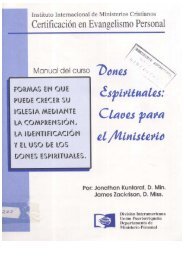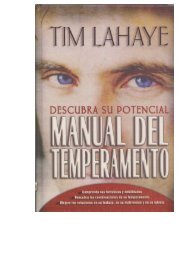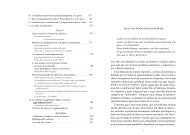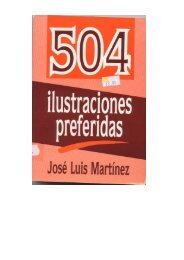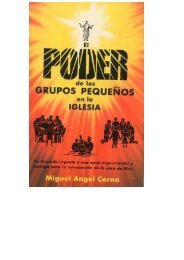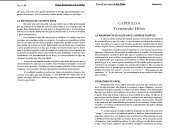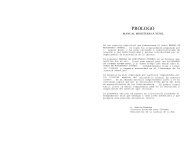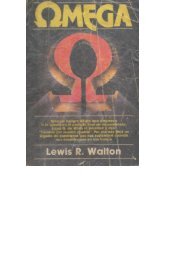Recapitulation in Revelation 4-11 - Ptr. Arturo Quintero
Recapitulation in Revelation 4-11 - Ptr. Arturo Quintero
Recapitulation in Revelation 4-11 - Ptr. Arturo Quintero
- No tags were found...
Create successful ePaper yourself
Turn your PDF publications into a flip-book with our unique Google optimized e-Paper software.
<strong>Recapitulation</strong> <strong>in</strong> <strong>Revelation</strong> 4-<strong>11</strong>Ekkehardt MuellerBiblical Research InstituteIn approach<strong>in</strong>g the Book of <strong>Revelation</strong>, or at least certa<strong>in</strong> sections of the book, one has basically twooptions. One can chose recapitulation or progression. Op<strong>in</strong>ions on the structure of <strong>Revelation</strong> and on thedelimitation of certa<strong>in</strong> passages determ<strong>in</strong>e, to a large degree, whether one opts for one or the other of thesetwo possibilities.I will briefly def<strong>in</strong>e the terms and state the importance of the issue, then move on to modern representativesof recapitulation. Next, I will address the delimitation of crucial passages, and f<strong>in</strong>ally list the arguments<strong>in</strong> favor of recapitulation <strong>in</strong> Rev 4-<strong>11</strong>.I. Def<strong>in</strong>ition of Terms<strong>Recapitulation</strong>ists perceive several parts of the Apocalypse as somewhat repetitious, and each ofthese parts seems to lead to the f<strong>in</strong>al consummation. In other words, the author repeatedly leads his hearersand readers over the same ground, add<strong>in</strong>g a new perspective each time.Progression, as opposed to recapitulation, discerns only one f<strong>in</strong>al climax <strong>in</strong> the Book of <strong>Revelation</strong>.Everyth<strong>in</strong>g leads up to this culm<strong>in</strong>ation. For example, the seven trumpets do not, to a certa<strong>in</strong> extent, coverthe same ground which the seven seals have already encircled, but grow out of the seals and are theirextension. 1II. Importance of the IssueAlthough the issue of recapitulation may seem somewhat academic and complicated, its implicationsand its practical effects can be tremendous and far-reach<strong>in</strong>g. The question of progression or recapitulationmay not matter too much to a preterist, even though preterists often defend recapitulation. However, it is adecisive question for the person ma<strong>in</strong>ta<strong>in</strong><strong>in</strong>g the historical <strong>in</strong>terpretation of the Apocalypse. If one choosesprogression one will end up with a different end time scenario from the one recapitulationists hold. Correspond<strong>in</strong>gly,one will place the present time <strong>in</strong> another frame than would those who prefer recapitulation.This aga<strong>in</strong> may <strong>in</strong>fluence belief <strong>in</strong> the nearness of Christ’s second corn<strong>in</strong>g as well as one’s own lifestyle.III. Modern Exegetes and the Issue of <strong>Recapitulation</strong>It seemed that for some time recapitulation <strong>in</strong> the Book of <strong>Revelation</strong> had lost its attractiveness. Theconcept has been revitalized by Günther Bornkamm. 2 Russell Scott Morton, <strong>in</strong> discuss<strong>in</strong>g different procedureswith regard to f<strong>in</strong>d<strong>in</strong>g <strong>Revelation</strong>’s macrostructure, dist<strong>in</strong>guishes between source-critical approaches,l<strong>in</strong>guistic/literary analysis, recapitulation theory , and chiastic approaches, 3 although they do not necessarilyexclude each other.1 See Ekkehardt Müller, Microstructural Analysis of <strong>Revelation</strong> 4-<strong>11</strong>, Andrews University Sem<strong>in</strong>ary Doctoral DissertationSeries, Volume 21 (Berrien Spr<strong>in</strong>gs; Andrews UP, 1996), 12.2 See Günther Bornkamm. “Die Komposition der apokalyptischen Visionen <strong>in</strong> der Offenbarung Johannis,” Zeitschrift fürdie neutestamentliche Wissenschaft 36 (1937): 132-149.3 Russell Scott Morton. “A History of Religions Analysis of <strong>Revelation</strong>s 4-5” (Th.D. dissertation, Lutheran School ofTheology at Chicago, 1985), 5-38.Page 1
Adela Yarbro Coll<strong>in</strong>s detects recapitulation <strong>in</strong> all the visions of the Apocalypse except the first septenary.The recurr<strong>in</strong>g pattern <strong>in</strong> these septet visions is, <strong>in</strong> her op<strong>in</strong>ion, (1) persecution, (2) judgment, and (3)salvation 4 . The paradigm for these elements of what she calls the combat myth is allegedly Rev 12. Shestates: “Each cycle of visions tells the story of the end <strong>in</strong> its own way. The story of the open<strong>in</strong>g of the scrollwith seven seals is the whole story of the end. This story is told aga<strong>in</strong> <strong>in</strong> the cycle of the trumpets fromanother po<strong>in</strong>t of view. This repetition is somewhat like that of a musical theme and variations.” 5Jan Lambrecht’s ma<strong>in</strong> emphasis is the encompass<strong>in</strong>g technique that John uses. This technique allowsat the same time for recapitulation and progression. In his view, the septets of the seals and trumpets areopen-ended and comprise everyth<strong>in</strong>g that follows. However, despite the overlap that now occurs, eachmajor block is a unit. 6Gerhard Krodel also argues for recapitulation. In Rev 6:12-14, the stars fall down from heaven. “However,the fourth trumpet and the fourth bowl visions presuppose that the heavenly bodies are still <strong>in</strong> place(8:12; 16:8). The relationship between the three cycles therefore is thematic, not chronological!” Furthermore,he states: “<strong>Recapitulation</strong> does not imply mechanical repetition of content, but recapitulation becomesthe occasion for new emphases.” 7Kenneth A. Strand’s chiastic structure of the Apocalypse consists of eight basic visions besides aprologue and an epilogue. Six of the eight visions can be subdivided <strong>in</strong>to a “victorious-<strong>in</strong>troduction scene,”a “basic prophetic description,” an “<strong>in</strong>terlude,” and the “eschatological culm<strong>in</strong>ation.” 8 This very arrangementstrongly po<strong>in</strong>ts to recapitulation.Jon Paulien argues that the protection of certa<strong>in</strong> objects from destruction <strong>in</strong> Rev 7:1-3 and Rev 9:4“raises serious questions whether the trumpet series is to be related as an immediate sequel to the vision ofchapter 7.” The strongest parallel between Rev 7a and the trumpets is Rev 9:14, 16. In Rev 7a, God’speople are described, “<strong>in</strong> Rev 9 their demonic counterparts.” Connections between the two passages <strong>in</strong>cludethe concept of b<strong>in</strong>d<strong>in</strong>g and los<strong>in</strong>g, the appearance of four angels, and the concept of number<strong>in</strong>g apeople. “The sixth trumpet is the exact historical counterpart of <strong>Revelation</strong> 7:1- 8 . . . The seven trumpets,therefore, do not follow the events of <strong>Revelation</strong> 7 <strong>in</strong> chronological order.” 9Richard M. Davidson po<strong>in</strong>ts out that the <strong>in</strong>troductory scenes—compared with each other—show progression,whereas the sections to which they belong often present recapitulation. 10Although Bruce M. Metzger perceives the seventh seal as an <strong>in</strong>troduction to a new series of visions,he adds: “The trumpets more or less repeat the revelation of the seven seals, though they present it more4 Adela Yarbro Coll<strong>in</strong>s, The Combat Myth <strong>in</strong> the Book of <strong>Revelation</strong> (Missoula, MT: Scholars. 1976).32-44; idem. “‘Whatthe Spirit Says to the Churches’: Preach<strong>in</strong>g the Apocalypse,” Quarlerly Review 4 (1984): 73.5 Adela Yabro Coll<strong>in</strong>s, The Apocalypse, New Testament Message. Biblical-Theological Commentary (Wilm<strong>in</strong>gton. DE:Michael Glazier, 1979), 43.6 J. Lambrecht, “A Structuration of <strong>Revelation</strong> 4,1-22.5,” <strong>in</strong> L ‘Apocalypse johannique et l’apocalyptique dans le NouveauTestament, ed. J. Lambrecht. Bibliotheca Ephemeridum Theologicarum Lovaniensium LII (Gembloux: Éditions J. Duculot,1980), 77-104. Lambrecht’s proposed open-endedness is derived from three po<strong>in</strong>ts: (1) The seventh seal and the seventh trumpetdo not have a specific content. (2) There is no <strong>in</strong>dication for the end of the third woe. (3) A study of the hymnic material suggeststhe conclusion that Rev <strong>11</strong> :15-19 and 15:1-16:1 belong together as 8:1 and 8:2-5 also do.7 Gerhard A. Krodel, <strong>Revelation</strong>, Augsburg Commentary on the New Testament (M<strong>in</strong>neapolis: Augsburg, 1989), 190.8See Kenneth A. Strand, “The Eight Basic Visions <strong>in</strong> the Book of <strong>Revelation</strong>,” Andrews University Sem<strong>in</strong>ary Studies 25(1987): 107-21.9 Jon Paul<strong>in</strong>e, Decod<strong>in</strong>g <strong>Revelation</strong>’s Trumpets: Literary Allusions and Interpretations of <strong>Revelation</strong> 8:7-12, AndrewsUniversity Sem<strong>in</strong>ary Doctoral Dissertation Series, vol. xi (Berrien Spr<strong>in</strong>gs, MI: Andrews UP, 1988), 196-197.10 See Richard M. Davidson, “Sanctuary Typology,” <strong>in</strong> Symposium on <strong>Revelation</strong>—Book I: Introductory and ExegeticalStudies, ed. F. B. Holbrook, Daniel and <strong>Revelation</strong> Committee Series, vol. 6 (Silver Spr<strong>in</strong>g, MD: Biblical Research Institute,1992), <strong>11</strong>5-<strong>11</strong>6.Page 2
from God’s standpo<strong>in</strong>t. . . Follow<strong>in</strong>g this complicated and repetitious pattern, John preserves unity <strong>in</strong> hiswork, <strong>in</strong>terlock<strong>in</strong>g the various parts together and at the same time develop<strong>in</strong>g his themes. The development,however, is not <strong>in</strong> a strictly logical fashion, such as we are familiar with <strong>in</strong> Western writ<strong>in</strong>g; it is,rather, a product of the Semitic m<strong>in</strong>d, which runs through the whole picture aga<strong>in</strong> and aga<strong>in</strong>. Thus, theseven seals and the seven trumpets essentially tell the same th<strong>in</strong>g, each time emphasiz<strong>in</strong>g one or anotheraspect of the whole.” <strong>11</strong>This brief review <strong>in</strong>dicates that the idea of recapitulation <strong>in</strong> <strong>Revelation</strong> is not uncommon amongmodern scholarship. However, the biblical text has to be studied on its own. This is the step we have to turnto.IV. <strong>Recapitulation</strong> and the Delimitation of PassagesMost scholars would agree that Rev 1 consists of an <strong>in</strong>troduction to the entire Book of <strong>Revelation</strong>(1:1-8) and a vision that should be regarded as an <strong>in</strong>troduction to the seven letters (1:9-20). 12 This meansthat the first septet has an <strong>in</strong>troductory scene, a device one will also f<strong>in</strong>d with the other major parts of<strong>Revelation</strong>. There is also a clear-cut end of this first septet at Rev 3:22 and the beg<strong>in</strong>n<strong>in</strong>g of a new sectionwith Rev 4:1, although 3:21 already prepares the way for the next section of <strong>Revelation</strong>. 13The question where the seven seals end and where a new block beg<strong>in</strong>s, however, is of vital importance,for it has to do with the very issue of recapitulation, and it decisively affects the <strong>in</strong>terpretation of<strong>Revelation</strong>, as we have already po<strong>in</strong>ted out above.Several scholars suggest that the seven seals comprise the rest of the book. Out of the seventh seal theother judgment series come forth, at least the seven trumpets. 14 This view is largely dependent on the<strong>11</strong> Bruce M. Metzger, Break<strong>in</strong>g the Code: Understand<strong>in</strong>g the Book of <strong>Revelation</strong> (Nashville: Ab<strong>in</strong>gdon, 1993), 55-56.12 For example, Eugenio Cors<strong>in</strong>i, The Apocalypse: the Perennial <strong>Revelation</strong> of Jesus Christ, Good News Studies, vol. 5(Wilm<strong>in</strong>gton, DE: Michael Glazier, 1983), 62,65; Elisabeth Schüssler Fiorenza, “Composition and Structure of the Book of<strong>Revelation</strong>,” The Catholic Biblical Quarterly 39 (1977): 364; Mart<strong>in</strong> Karrer, Die Johannesoffenbarung als Brief: Studien zuihrem literarischen. historischen und theologischen Ort, Forschung zur Religion und Literatur des Alten und Neuen Testaments,vol. 140 (Gött<strong>in</strong>gen: Vandenhoeck & Ruprecht, 1986), 217-219. Kenneth A. Strand, Interpret<strong>in</strong>g the Book of <strong>Revelation</strong>:Hermeneutical Guidel<strong>in</strong>es, with Brief Introduction to Literary Analysis, rev. and enl. ed. (Worth<strong>in</strong>gton, OH: Ann Arbor, 1976),51, perceives the vision of chap. 1 and the seven churches as one unit, but he starts only with 1:<strong>11</strong>.13 See the terms “throne” and “overcomer.” Indicators for a new part of <strong>Revelation</strong> start<strong>in</strong>g with 4: 1 are the follow<strong>in</strong>g: (1)Rev 4 beg<strong>in</strong>s with the formula “after this I saw, and behold” (meta tauta eidon, kai idou.) John sees an open door <strong>in</strong> heaven andis <strong>in</strong>vited to come up there to learn what will happen “after this” (meta tauta) (4:1). The Book of <strong>Revelation</strong> conta<strong>in</strong>s severalstructur<strong>in</strong>g formulas. Work<strong>in</strong>g through the entire document, one gets the impression that no formula besides “and I saw” (kaieidon) and those derived from it “and I saw, an behold, after this I saw; after this I saw, and behold; and I saw, and I heard” (kaieidon, kai idou; meta touto eidov; meta tauta eidon, kai idou; kai eidon, kai ‘kousa) have the same structur<strong>in</strong>g force. “I saw”(eidon) without the conjunction “and” (kai) or without the prepositional phrase “after this/I saw” (meta touto/meta tauta) neveroccurs at the beg<strong>in</strong>n<strong>in</strong>g of a sentence, as the structur<strong>in</strong>g formulas do, and has little or no force as a structur<strong>in</strong>g element. Theformulas “and behold” (kai idou) and “and” (kai) “I heard” (kai ‘kousa) seem to have some value for structur<strong>in</strong>g passages. Theyare, however, much weaker than is “and I saw” (kai eidon) and often seem to be dependent on it. Forms of the verb “to see”(eidon) occur <strong>in</strong> Rev 1, but not at all <strong>in</strong> Rev 2-3. Yet, even <strong>in</strong> Rev 1, “and I saw”(kai eidon) and derived forms are not found. Thefirst clear structur<strong>in</strong>g formula comes <strong>in</strong> Rev 4:1. This is a strong <strong>in</strong>dication that a new section starts with 4:1. (2) In the firstchapters of the Apocalypse, a movement from earth to heaven takes place. Rev 1-3 seems to play on earth. In Rev 4, John <strong>in</strong> thespirit sees heavenly realities, an entire new sett<strong>in</strong>g. (3) There is also a change <strong>in</strong> personages. The churches of Rev 2-3 fade away,and a throne with the one sitt<strong>in</strong>g on it, twenty-four elders, and four be<strong>in</strong>gs appear. In Rev 5, angels and a lamb are added. (4) Rev4-5 functions as an <strong>in</strong>troduction to the next septet <strong>in</strong> the same way that Rev 1:9-20 <strong>in</strong>troduces the first. (5) Compared with thefirst septet, there is a change of style with the second one. The former uses the style of a letter; <strong>in</strong> the latter, narrative and hymnsoccur.14 See, for example, Gary G. Cohen, Understand<strong>in</strong>g <strong>Revelation</strong>: An Investigation of the Key Interpretational andChronological Questions Which Surround the Book of <strong>Revelation</strong> (Chicago: Moody, 1978), 96; Hans Werner Günther, DerNah- und Enderwartungshorizont <strong>in</strong> der Apokalypse des heiligen Johannes, Forschung zur Bibel (Würzburg: Echter Verlag,Page 3
<strong>in</strong>terpretation of the silence which occurs when the seventh seal is opened. The question is whether thesilence is the climax of the series or whether it forms the <strong>in</strong>troduction to another series. 15If the seventh seal reaches up to Rev 8:5 or Rev 8:6, the seven trumpets seem to grow out of the sevenseals and are their extension. In the same way, the seven bowls may grow out of the seventh trumpet. In thiscase, there is not much room for recapitulation. If, on the other hand, the seven seals end with Rev 8:1, anew section starts with 8:2. In this case, one might opt for recapitulation.Some exegetes suggest a k<strong>in</strong>d of overlap between the end of the seven seals and the beg<strong>in</strong>n<strong>in</strong>g of theseven trumpets, us<strong>in</strong>g the device of “<strong>in</strong>terlock<strong>in</strong>g” or “<strong>in</strong>tercalation.” This means that the seals seriescomprises 4:1-8:5 or 4:1-8:6 and the trumpet series 8:2-<strong>11</strong>:19 or 8:3-<strong>11</strong>:19. 16Among other scholars who perceive Rev 8:1 as the end of the section, irrespective of the question ofwhether Rev 4-5 is an <strong>in</strong>troduction to the seals only or rather to a larger portion of <strong>Revelation</strong>, 17 areStrand, 18 Bowman, 19 and Holbrook. 20 Accord<strong>in</strong>g to their <strong>in</strong>terpretation, the septet beg<strong>in</strong>s with Rev 4 andends with 8:1.Start<strong>in</strong>g with Rev 8:7, the seven trumpets are described as the seals are <strong>in</strong> Rev 6. What about thesection 8:2-6? Indeed, many words are parallel between Rev 4:1-8:1 and Rev 8:2-6. 21 However, some ofthe words are not important for our purpose. They occur everywhere <strong>in</strong> <strong>Revelation</strong> and belong to thecommon stock of vocabulary <strong>in</strong> <strong>Revelation</strong>. They do not <strong>in</strong>dicate progression. Sometimes words are used<strong>in</strong> a different way and with a different mean<strong>in</strong>g <strong>in</strong> other places. 22 Some words come <strong>in</strong> clusters or formulas1980), 235; Krodel, 150-151; Coll<strong>in</strong>s, The Apocalypse, 55, supports this view, but she states that “this relationship should not beunderstood chronologically. . . The <strong>in</strong>terlock<strong>in</strong>g of the two cycles is a literary device.” See also ibid., 56. Rolf J. Pöhler, “Derliterarische Aufbau der Offenbarung des Johannes,” <strong>in</strong> Studien zur Offenbarung: Die Bedeutung der drei Engelsbotschaften -heute (Offenbarung 14,6-12) (Hamburg: Gr<strong>in</strong>deldruck, 1988), 1:69-71, suggests what he calls a telescope theory.15 See, for example, Richard Fredericks, “A Sequential Study of <strong>Revelation</strong> 1-14 Emphasiz<strong>in</strong>g the Judgment Motif: WithImplications for Seventh-day Adventist Apocalyptic Pedagogy” (Ph.D. dissertation, Andrews University, 1987), 185-87, whopo<strong>in</strong>ts to Hab 2:20, Zeph 1:7, Zech 2:13, and consequently understands the silence as a symbol of the “day of the Lord.” Seealso Jean-Pierre Charlier, Comprendre l’Apocalisse, 2 vols. (Paris: Les Éditions du Cerf, 1991), 1:194-195. Mathias Rissi, Wasist und was geschehen soll danach: Die Zeit- und Geschichtsauffassung der Offenbarung des Johannes (Zürich: Zw<strong>in</strong>gli Verlag,1965), 8-<strong>11</strong>, also connects the silence with the day of the Lord. It is a climax and not a transition to the next septenary. On theother hand, Henry Barclay Swete, The Apocalypse of St. John: The Greek Text with Introduction Notes and Indices (London:Macmillan, 1917),107, th<strong>in</strong>ks the OT texts are not relevant with regard to Rev 8:1. Jürgen Roloff, The <strong>Revelation</strong> of John: ACont<strong>in</strong>ental Commentary (M<strong>in</strong>neapolis: Fortress, 1993), 101-102, states: “In fact, the silence <strong>in</strong> heaven appears to be a referenceto the end-time work of God’s new creation.”16 See, for example, Coll<strong>in</strong>s, The Combat Myth, 16-19; and Leroy C. Sp<strong>in</strong>ks, “A Critical Exam<strong>in</strong>ation of J. W. Bowman’sProposed Structure of the <strong>Revelation</strong>,” Evangelical Quarterly 50 (1978): 216.17 See, for example, Cors<strong>in</strong>i, <strong>11</strong>8, 161; Michel Gourgues, “‘L’ Apocalypse’ ou ‘Les trois apocalypses’ de Jean?” Scienceet Esprit 35 (1983): 304-3<strong>11</strong>; Rissi, 8-<strong>11</strong>; Ernst R. Wendland, “7 X 7 (X 7): A Structural and Thematic Outl<strong>in</strong>e of John’sApocalypse,” Occasional Papers <strong>in</strong> Translation and Textl<strong>in</strong>guistics: OPTAT 4 (1990): 376-78; Vester Eugene Wolber, “AStudy of the Literary Structure of <strong>Revelation</strong> as an Aid to Interpretation” (Th.D. dissertation, Southwestern Baptist TheologicalSem<strong>in</strong>ary, 1950), 36, 39, 42, 61; and Theodor Zahn, Die Offenbarung des Johannes, repr<strong>in</strong>t (Wuppertal: R. Brockhaus Verlag,1986), 364.18 Strand, Interpret<strong>in</strong>g the Book of <strong>Revelation</strong>, 48; idem, “The Eight Basic Visions,” <strong>11</strong>2.19 John Wick Bowman, “The <strong>Revelation</strong> to John: Its Dramatic Structure and Message.” Interpretation 9 (1955): 441.20 Frank B. Holbrook, “Issues <strong>in</strong> the Book of <strong>Revelation</strong>,” M<strong>in</strong>istry, January 1991, 10-<strong>11</strong>, summariz<strong>in</strong>g a committeestatement, declares that Rev 4:1-8:1 belongs to the historical section of <strong>Revelation</strong>. Rev 8:2-6 forms the <strong>in</strong>troduction to thesequence of the trumpets <strong>in</strong> the form of an <strong>in</strong>clusion.21 In each case just one reference per section is given: I saw (6:1; 8:2), seven (6:1; 8:2), angels (7:1; 8:2), God (6:9; 8:2),stood (7:<strong>11</strong>; 8:2) trumpets (4:1; 8:2), another angel (7:2; 8:3), came (6:17; 8:3), altar (6:9, 8:3), hav<strong>in</strong>g (6:2; 8:3), golden (4:4;8;3), it was given him (6:2; 8:3) <strong>in</strong>cense (5:8; 8:3), prayers of the sa<strong>in</strong>ts (5:8; 8:3), every/all (6:15; 8:3), before the throne (4:5;8:3), hand (6:5; 8:4), took (5:7; 8:5), time (4:5; 8:5), cast (4:10, 8:5), earth (6:4; 8:5), was/were (6:12; 8:5), thunder and voicesand flashes of lightn<strong>in</strong>g (4:5; 8:5), and earthquake (6:12; 8:5).22 For example, the golden altar <strong>in</strong> Rev 8:3 is not necessarily identical with the altar <strong>in</strong> Rev. 6:9.Page 4
which are also found <strong>in</strong> other parts of Rev. 23 Some may even <strong>in</strong>dicate that a new section has begun. 24 Noneof this vocabulary can be used to build a case for progression. On the other hand, the terms “altar,” “<strong>in</strong>cense,”and the “prayers of the sa<strong>in</strong>ts” apparently form an important connection with 4:1-8:1. Nevertheless,Rev 8:2-5(6) does not seem to be part of the seventh seal. It is, rather, the <strong>in</strong>troduction to the nextseptet. 25 This conclusion is supported by the follow<strong>in</strong>g evidence:1. 8:2-6 forms an <strong>in</strong>clusion 26 which is immediately followed by the <strong>in</strong>dividual trumpets: 27A Seven angels with seven trumpets (2)B Another angel (3-5)A’ Seven angels with seven trumpets (6)One might even go further and suggest a more detailed structure of this passage.A Seven angels with seven trumpets (2)B Angel, altar, censer (3a)C Incense, prayers of the sa<strong>in</strong>ts (3b)D Altar before the throne (3c)C’ Incense, prayers of the sa<strong>in</strong>ts (4)B’ Angel, censer, altar (5)A’ Seven angels with seven trumpets (6)Rev 8:1 does not seem to have a place <strong>in</strong> this chiastic structure or <strong>in</strong> the <strong>in</strong>clusion, if one takes it assuch. Obviously it lies outside the boundaries of the passage.2. In <strong>Revelation</strong> “and I saw” (kai eidon) oftentimes <strong>in</strong>troduces a new section or at least a new aspectof a vision. 28 In the first six seals, the formula “and I saw” (kai eidon) and related formulas, which seem tocome as a package, set off one seal from the follow<strong>in</strong>g one and are not preceded but followed by the contentof the respective seal.In the seventh seal the content is presented immediately without the vision formula. This formula isonly <strong>in</strong>troduced <strong>in</strong> 8:2. If Rev 8:2-5 belongs to the seventh seal, the pattern that the content follows thevision formula is obviously destroyed. Another option that some persons might want to propose would beto regard the silence as not be<strong>in</strong>g the content or not belong<strong>in</strong>g to the content of the seventh seal, tak<strong>in</strong>g it<strong>in</strong>stead more as a k<strong>in</strong>d of formula. However, the audition formula occurr<strong>in</strong>g with the first four seals,<strong>in</strong>clud<strong>in</strong>g the statement of what has been heard–a liv<strong>in</strong>g creature says: “Come!”—differs widely from 8:1.A formula becomes a formula only by repetitive use, not by be<strong>in</strong>g used just once. On the other hand, thesilence is connected to a time element. Even if we might not precisely understand its mean<strong>in</strong>g, this sett<strong>in</strong>gseems to <strong>in</strong>dicate that the idea connected with the time element—<strong>in</strong> this case the silence <strong>in</strong> heaven—is23 For example, “and I saw” (kai eidon) and “and it was given” (kai edoth‘) ,24 For example, “and I saw” (kai eidon) and “thunder and voices and flahes of lightn<strong>in</strong>g (and earthquake)” (brontai kaiphÇnai kai astrapai (kai seismos). The latter enumeration occurs also <strong>in</strong> 4:5; <strong>11</strong>:19; and 16:18 and seems to be used only onceper vision <strong>in</strong> what Strand calls victorious <strong>in</strong>troduction scenes; Strand, “The Eight Basic Visions,” <strong>11</strong>2-<strong>11</strong>3.25See, for example, Cors<strong>in</strong>i, 171, and Charlier, 1:203. Swete, 109, states: “The whole scene <strong>in</strong> vv. 3-5 is a prelude to theSeven Trumpets, which now beg<strong>in</strong> to sound.”26 See, for example, Adolf Phl, Die Offenbarung des Johannes, Wuppertaler Studienbibel (Wuppertal: R. BrockhausVerlag, 1982), 2:20. Elisabeth Schüssler Fioeranza, <strong>Revelation</strong>: Vision of a Just World, Proclamation Commentaries (M<strong>in</strong>neapolis:Fortress, 1991), 70, states that the heavenly liturgy <strong>in</strong> Rev 8:3-5 is sandwiched or <strong>in</strong>tercalated between 8:2 and 8:6-9:21a.Krodel, 194, po<strong>in</strong>ts to the A-B-A’ structure of Rev 8:2-6.27 See, for example, Wendland, 379.28 See, for example, Rev 8:13 and the discussion on <strong>in</strong>troductory formulas with<strong>in</strong> footnote 13.Page 5
important enough to be regarded as the content of the seventh seal. S<strong>in</strong>ce, especially with the fifth and thesixth seal “and I saw” (kai eidon) is used right <strong>in</strong> the beg<strong>in</strong>n<strong>in</strong>g, it might be better to understand “and I saw”(kai eidon) <strong>in</strong> 8:2 as <strong>in</strong>troduc<strong>in</strong>g a new part of the Apocalypse. 29The Four HorsemenPackage of <strong>in</strong>troductory formulaslamb audition liv<strong>in</strong>g vision Content of theopens formula creature formula respective seala sealsay<strong>in</strong>gFirst rider 30 * * * * *Second rider * * * – *Third rider * * * * * 31Fourth rider * * * * *The Last Three SealsPackage of <strong>in</strong>troductory formulasvision lamb vision Content of theformula opens formula respective seala sealFirst seal * * *Sixth seal * * *Seventh seal * *3. Vision formulas are found throughout the entire seal series. There is no other septet <strong>in</strong> Rev characterizedby “and I saw” (kai eidon) statements as is the vision of the seven seals, <strong>in</strong>clud<strong>in</strong>g its <strong>in</strong>troductorypart. With the trumpets this formula is found only rarely.4. The seven trumpets start with a common formula, namely “and the. . .angel sounded the trumpet”(kai. . .angelos esalpisen) This formula is prefigured by 8:2 and 6. It is quite different from that of the seals“and when it opened the. . .seal [I heard the. ..liv<strong>in</strong>g be<strong>in</strong>g say<strong>in</strong>g]” (Kai hote ‘noixen t‘n sphragida t‘n. ..[‘kousa tou . .zÇou legontos]) which draws on Rev 4-5. Instead of view<strong>in</strong>g the trumpets as com<strong>in</strong>g out ofthe last seal, it seems to be more appropriate to perceive Rev 4-5 and Rev 8:2-6 as <strong>in</strong>troductory scenesprovid<strong>in</strong>g the vocabulary for the <strong>in</strong>troductory formulas used with each element of the respective septet.5. In compar<strong>in</strong>g septenaries it is often helpful to take a look at the particular personnel that appear.The vision of 4:1-8:1 is dom<strong>in</strong>ated by the lamb, four liv<strong>in</strong>g creatures, and twenty-four elders. The lamb isfound ten times with<strong>in</strong> the seal series, but not at all with the trumpets. In the seals, angels are only <strong>in</strong>tro-29 See E. Müller, 200-201, 317-325, and 422-423. The possible argument that <strong>in</strong> 5:5-6—with<strong>in</strong> the same vision—Johnhears about a lion yet sees a lamb, so the same technique must be applied to the seventh seal—John “hears” the silence but seesthe seven angels with seven trumpets and therefore the trumpets have to be <strong>in</strong>cluded <strong>in</strong>to the seventh seal—does not seem to bevalid. Lion and lamb refer to the same reality, the same person. The silence <strong>in</strong> heaven and the blow<strong>in</strong>g of the trumpets with theeffects on earth obviously do not.30 The very first occurrence of the vision formula <strong>in</strong> 6:1 has been omitted here s<strong>in</strong>ce it sets off the actual open<strong>in</strong>g of theseals from the heavenly scene <strong>in</strong> Rev 5 which, together with Rev 4, forms an extended <strong>in</strong>troduction scene to the seal septet.31 Another audition formula has been added here.Page 6
duced later (Rev 5 and Rev 7). There are four angels <strong>in</strong> 7:1-2, not seven as <strong>in</strong> 8:2, 6. 32 Right at the beg<strong>in</strong>n<strong>in</strong>gof the seals the four liv<strong>in</strong>g creatures and the lamb are found, whereas <strong>in</strong> the case of the trumpets angelsare mentioned. S<strong>in</strong>ce no angels occur <strong>in</strong> the first six seals, with the exception of the expansion of the sixthseal—a special case <strong>in</strong> itself—one probably should not expect to f<strong>in</strong>d them <strong>in</strong> the seventh seal. In otherwords, the personnel <strong>in</strong> the two septets are quite different. This is also true if one leaves the heavenlysphere. The trumpets seem to focus on the earth dwellers (8:13). In the case of the seals the focus seems tobe somewhat more on the people of God. 33 This evidence would support recapitulation.6. “Thunder, voices, flashes of lightn<strong>in</strong>g” (brontai kai phÇnai kai astrapai) depictions of theophany, aswell as “<strong>in</strong>cense” (thumiamata) <strong>in</strong> connection with “prayers of the sa<strong>in</strong>ts” (proseuchais tÇn hagiÇn) are onlyfound <strong>in</strong> the <strong>in</strong>troductory scene Rev 4-5, not <strong>in</strong> the seals themselves. The three-fold enumeration of naturalphenomena is aga<strong>in</strong> used <strong>in</strong> the <strong>in</strong>troductory scene of Rev <strong>11</strong>:19. 34 It would be fitt<strong>in</strong>g to f<strong>in</strong>d these items <strong>in</strong>another <strong>in</strong>troductory scene and not <strong>in</strong> an extension of the seventh seal. Although there are some literaryconnections between Rev 8:2-6 and the seals, 35 as <strong>in</strong>dicated above, they cannot prevent one from view<strong>in</strong>gRev 8:2-6 as an <strong>in</strong>troductory scene to the seven trumpets. The different <strong>in</strong>troductory scenes of the ma<strong>in</strong>visions of <strong>Revelation</strong> are apparently temple scenes. Therefore—<strong>in</strong> spite of all differences between them—one has to expect common elements and even progression if one takes these scenes by themselves.7. S<strong>in</strong>ce Rev 8: 1 is <strong>in</strong>troduced by neither “I saw”(kai eidon) nor “I heard” (kai ‘kousa), it seems thatthis verse has a very close relation to the preced<strong>in</strong>g material, which po<strong>in</strong>ts to the Christ’s Second Com<strong>in</strong>g“sixth seal” (parousia) and perceives God’s people as already stand<strong>in</strong>g before His throne (Rev 7:15). Theclimax has been reached. With the sixth seal, not only the heavenly signs po<strong>in</strong>t<strong>in</strong>g to Jesus’ second com<strong>in</strong>ghave been fulfilled. The day of the Lord itself has come. The expansion of the sixth seal, namely Rev 7,answers the question at the very end of the sixth chapter: “Who is able to stand?” and describes the personswho will be found before God’s throne, led by the lamb to the water of life. The seventh seal adds silence<strong>in</strong> heaven. So, the seals lead up to the f<strong>in</strong>al consummation. Hav<strong>in</strong>g reached Christ’s second corn<strong>in</strong>g, theMillennium, judgment, and new creation, a return to the old earth as described by the effects of the trumpetsdoes not make sense if understood chronologically. If Rev 8:2-6—which draws with it Rev 8-9—would be connected with 8:1, the progression of Rev 6-7 up to 8:1 would be reversed and the climaxdestroyed. There seems to be a movement from heaven to earth and back to heaven <strong>in</strong> order to reach thef<strong>in</strong>al consummation, as po<strong>in</strong>ted out <strong>in</strong> both septenaries.Basic Locations <strong>in</strong> Rev 4:1-8:1 and <strong>in</strong> Rev 8:2-<strong>11</strong>:18Heaven Earth HeavenRev 4-5 Rev 6:1-7:8 Rev 7:9-8:1thunder, voices, 6 seals part of the 6 thflashes of lightn<strong>in</strong>g;seal, 7 th seal;<strong>in</strong>censeclimax32 Seven angels are mentioned <strong>in</strong> 15:1, 6-8; 16:1; 17:1; and 21:9. ,33 See especially the fifth seal.34 Actually, each time thunder, voices, and flashes of lightn<strong>in</strong>g are enumerated and augmentation takes place. Threeelements are found <strong>in</strong> Rev 4:5. Rev. 8:5 adds earthquakes. In Rev. <strong>11</strong>:19 a fifth element is stated, namely a great hail (chalazamegal‘). See also Rev. 16:18-21.35 For example, an altar is mentioned <strong>in</strong> Rev 6:9 as well as <strong>in</strong> Rev 8:3. Yet the altar of 6:9 is not characterized as the goldenaltar, as is the case <strong>in</strong> 8:3, and might refer to the altar of burnt offer<strong>in</strong>g. The martyrs are found there, but no <strong>in</strong>cense. Furthermore,the blood of the martyrs and the death of other sa<strong>in</strong>ts are mentioned.Page 7
Heaven Earth HeavenRev 8:2-6 Rev 8:7-<strong>11</strong>:14 Rev <strong>11</strong>:12, 15-18thunder, voices, 6 trumpets part of the 6 thtrumpet,trumpet,flashes of lightn<strong>in</strong>g,7 th trumpet;earthquake; <strong>in</strong>censeclimax8. Both visions, Rev 4:1-8:1 and Rev 8:2-<strong>11</strong>:18, seem to form a k<strong>in</strong>d of chiastic structure <strong>in</strong> themselves.In the first one, the lamb is the center of attention. In Rev 8:2-<strong>11</strong>:18, angels are very important. Rev4:1-2a sets the stage for Rev 4—8a. Rev 8:1, on the other hand, concludes the vision. Although bothpassages are small, there are a number of similarities between Rev 4:1-2a and Rev 8:1. The terms “toopen,” (anoigÇ) “as/like” and “to be/become” (g<strong>in</strong>omai) occur <strong>in</strong> both passages. Furthermore, the prepositionalphrase “<strong>in</strong> heaven” (en tÇ ouranÇ) is found <strong>in</strong> both texts. 36 In Rev 4:1-2a, a door <strong>in</strong> heaven wasopened, and a voice talked to John. In Rev 8:1, the seventh seal was opened, and there was silence <strong>in</strong>heaven for a limited time. These two passages are a fitt<strong>in</strong>g frame for the vision of Rev 4- 7. Their similaritiesand their contrasts both prepare the way for the vision and conclude it. When the consummation hascome, no further speech is necessary. Wendland calls 4:1-8:1 “a contrastive <strong>in</strong>clusion.” 37Scholars propose an outl<strong>in</strong>e of this septet that consists of (1) an <strong>in</strong>troduction (Rev 4-5), (2) six seals(Rev 6; four plus two plus later one more), (3) an <strong>in</strong>terlude (Rev 7), and (4) the seventh seal (Rev 8:1). 38This study suggests the elements pr<strong>in</strong>ted below. At the same time, as at least partially <strong>in</strong>dicated by thisoutl<strong>in</strong>e, Rev 4:1-8:1 seems to form a k<strong>in</strong>d of chiastic structure with regard to the occurrence of hymns andthe place of action. 39 The Structure of Rev 4:1-8:1(1) Prelude or general <strong>in</strong>troduction (heavenly sett<strong>in</strong>g—4:1-2a)(2) Introductory scene (heavenly sett<strong>in</strong>g—4:2a-5: 14)(a) Throne vision (<strong>in</strong>clud<strong>in</strong>g hymns—4:2b-<strong>11</strong>)(b) The vision of the lamb and the scroll (<strong>in</strong>clud<strong>in</strong>g hymns—5)(3) The seven seals (6:1-8:1)(a) The four horsemen (6:1-8)(b) The fifth seal (6:9-<strong>11</strong>)36 The only other places <strong>in</strong> this part of <strong>Revelation</strong> <strong>in</strong> which this phrase is employed are Rev 5:3 and Rev 5:13.37 Wendland 378.38 See, for example, Günther, 162, although he takes only 5:1 to 8:1 as a section; Strand, “The Eight Basic Visions,” <strong>11</strong>2;and Wendland, 376-78. Ferd<strong>in</strong>and Han, “Zum Aufbau der Johannesoffenbarung” <strong>in</strong> Kirche und Bibel: Festgabe für BischopEduard Schick, ed. Otto Böcher et al. (Paderborn: Ferd<strong>in</strong>and Schön<strong>in</strong>gh, 1979), 153, however, regards 6:12-7:8 as the sixthseal, whereas 7:9-17 conta<strong>in</strong>s a prospect of the consummation. Charlier, 1:197, proposes a detailed chiastic structure reach<strong>in</strong>gfrom A to H and to A’. He does not <strong>in</strong>clude Rev 4 <strong>in</strong> this septenary.39 Charlier, 1:150, suggests another chiastic structure:A Vision <strong>in</strong>augurale (5,1-14)B Les quatre premiers sceaux (6,1-8)C Le c<strong>in</strong>quième sceau (6,9-<strong>11</strong>)B’ Le sixième sceau (6,12-7,8)A’ La liturgie de clôture (7,9-8,1).Page 8
(c) The sixth seal (6:12-7:17)(i) The seal proper (6:12-17)(ii) First expansion: the 144,000 (7:1-8)(iii) Second expansion: the great multitude (heavenly sett<strong>in</strong>g, <strong>in</strong>clud<strong>in</strong>g hymns—7:9-17)(d) The seventh seal as conclusion (heavenly sett<strong>in</strong>g—8:1)The large picture, drawn <strong>in</strong> Rev 4:1-8:1, starts with God and the Lamb and with praises given to them.It ends <strong>in</strong> the same way, namely with the Lamb and God and the praises given to them, for the goal isachieved: God’s servants are with him and he is with them. The lamb is their shepherd, lead<strong>in</strong>g them to allthe resources of an abundant life.The Chiastic Structure of Rev 4:1-8:1A Prelude or general <strong>in</strong>troduction: heavenly sett<strong>in</strong>g (4:1-2a)B Introductory scene: heavenly sett<strong>in</strong>g, hymns (4:2a-5:14)C The first six seals, <strong>in</strong>clud<strong>in</strong>g the first expansion of the sixth seal (6:1-7:8)B’ The second expansion of the sixth seal: heavenly sett<strong>in</strong>g, hymns (7:9-17)A’ The seventh seal as conclusion: heavenly sett<strong>in</strong>g (8:1)9. In Rev 7:3 the earth, the sea, and the trees are not harmed. This is quite different from the firsttrumpet <strong>in</strong> 8:7, where a third of the earth and a third of the trees are burned up. Representatives of the ideaof progression po<strong>in</strong>t to this fact. However, <strong>in</strong> 9:4, when the fifth trumpet is blown, the earth and the treesare protected. 4010. Under the sixth seal the stars fall to the earth. The idea of stars is found aga<strong>in</strong> with the trumpets.They are still <strong>in</strong> their place up to the fourth trumpet, when they are struck. 4<strong>11</strong>1. The term “prayers of the sa<strong>in</strong>ts,” already mentioned, is found only twice <strong>in</strong> <strong>Revelation</strong>, namely <strong>in</strong>5:8 and <strong>in</strong> 8:3-4. These two passages seem to be parallel <strong>in</strong>sofar as they are <strong>in</strong>troduction scenes to basicvisions of the Apocalypse.12. The phrase “I heard their number” is found only <strong>in</strong> 7:4 and <strong>in</strong> 9:16. In the first case, it belongs tothe expansion of the sixth seal. In the other case, it is part of the sixth trumpet. Look<strong>in</strong>g at their respectivecontexts one detects the same ideas: hold<strong>in</strong>g back and releas<strong>in</strong>g, four angels, and a crowd which is numbered.In Rev 7 the people of God are depicted, and <strong>in</strong> Rev 9 their demonic counterpart. Therefore it seemsthat the sixth trumpet is the exact historic antagonist to the expansion of the sixth seal <strong>in</strong> Rev 7a. 42IV. Some Additional Arguments <strong>in</strong> Favor of <strong>Recapitulation</strong>1. The seal septet seems to start with the time of John. The twofold <strong>in</strong>troductory scene <strong>in</strong> Rev 4-5obviously po<strong>in</strong>ts to Jesus’ enthronement <strong>in</strong> heaven, which took place <strong>in</strong> 31 A.D. As already briefly h<strong>in</strong>tedat above, this septet reaches even beyond Christ’s second com<strong>in</strong>g. Thus it covers the entire Christian timespan. The vision follow<strong>in</strong>g the seven trumpets has been referred to as the vision on the satanic tr<strong>in</strong>ity. It40 See, for example, Jon Paulien, “Seals and Trumpets: Some Current Discussions,” <strong>in</strong> Symposium on <strong>Revelation</strong>-Book I:Introductory and Exegetical Studies, ed. F. B. Holbrook, Daniel and <strong>Revelation</strong> Committee, vol. 6 (Silver Spr<strong>in</strong>g, MD: BiblicalResearch Institute, 1992), 196.41 See, for example, Krodel, 190.42 See, for example, Paulien, “Seals and Trumpets” 196-197.Page 9
starts with a woman giv<strong>in</strong>g birth to a male child. The reference is undoubtedly to the birth of the Messiah.The vision mentions the three and a half times of Dan 7 and 12 and aga<strong>in</strong> covers the Christian period,<strong>in</strong>clud<strong>in</strong>g the medieval conflict as well as the end time persecution and the “parousia”. Therefore thequestion is not whether the Apocalypse uses recapitulation—this issue is clear—but whether the trumpetsrecapitulate the seals. In any case, recapitulation <strong>in</strong> the Book of <strong>Revelation</strong> cannot be negated categorically.It would be possible that it also applies to the trumpets. The above mentioned reasons foster thisview.2. With<strong>in</strong> the trumpet series several chronological statements are found. With regard to these timeelements the trumpet septet is much more structured than the seals are. The prophetic time elements ofchapter <strong>11</strong> which are part of the expansion of the sixth trumpet po<strong>in</strong>t to a long historic development andespecially focus on the end of this time span, namely around 1798 A.D. S<strong>in</strong>ce the trumpets evidently come<strong>in</strong> a chronological order, the first trumpets obviously precede this time and therefore seem to be more orless parallel to the seals. In any case, the trumpets conta<strong>in</strong> the 1260 prophetic days.3. An exposition of the seven seals demonstrates that the seals imitate the Synoptic Apocalypse <strong>in</strong>Matt 24 and its parallels. The difference is that the seals seem to concentrate on the spiritual dimension. Ifthe Synoptic Apocalypse, with its climax of Christ’s second com<strong>in</strong>g, is found <strong>in</strong> Rev 6:1 to 8:1, there is noroom left for partial judgments that are meant to lead persons to repentance (9:20-21), because the “parousia”has already happened before the trumpets are sounded, and after the “parousia” one has only to expect thef<strong>in</strong>al and universal judgment.4. A strong relation between the Book of <strong>Revelation</strong> and the Book of Daniel must be recognized. Boththe seal vision and the trumpet vision allude to certa<strong>in</strong> passages of Daniel. Both books belong to the sametype of literature, namely, apocalyptic prophecy. These are the only predom<strong>in</strong>antly apocalyptic books <strong>in</strong>the whole Bible. Thus there might be a certa<strong>in</strong> similarity or correspondence between them. The Book ofDaniel undeniably conta<strong>in</strong>s recapitulation. S<strong>in</strong>ce the Book of <strong>Revelation</strong> depends on the Book of Daniel,we might also expect recapitulation <strong>in</strong> the case of the Apocalypse. In Daniel one series adds additionalelements to the preced<strong>in</strong>g one. Whereas Dan 2 discusses the political dimension—that is, the k<strong>in</strong>gdoms ofthe world—Dan 7 adds a religious dimension, namely, the sa<strong>in</strong>ts, and Dan 8 adds another spiritual dimension,namely, the sanctuary. <strong>Recapitulation</strong> <strong>in</strong> <strong>Revelation</strong> seems to follow this pattern by add<strong>in</strong>g newaspects to formerly revealed historical developments. With the trumpets, these new facets <strong>in</strong>clude thedifferent time elements and the emphasis on those who dwell on the earth.ConclusionIn this paper I have wrestled with the question of recapitulation <strong>in</strong> <strong>Revelation</strong>, especially with regardto the seven trumpets. A very important question was the delimitation of the seventh seal. S<strong>in</strong>ce the seventhseal can be limited to Rev 8:1 and s<strong>in</strong>ce other reasons favor recapitulation, one is not forced to regard theseven trumpets as extensions of the last seal. On the contrary, recapitulation <strong>in</strong> the case of the seals andtrumpets seems to be a reasonable option. This is decisive for the <strong>in</strong>terpretation of the seals and the trumpets.Suggest<strong>in</strong>g that Rev 8:1 is the content of the seventh seal, however, does not mean that 8:2-5(6) istotally disconnected from the preced<strong>in</strong>g material. The passage seems to look back to a certa<strong>in</strong> degree at theprevious chapters and at the same time look forward to the next ma<strong>in</strong> part, serv<strong>in</strong>g as a k<strong>in</strong>d of jo<strong>in</strong>t <strong>in</strong> thelarger structure of <strong>Revelation</strong> (cf. 3, 21; <strong>11</strong>,18). This literary connection, however, does not necessarilypo<strong>in</strong>t to a chronological sequence of seals and trumpets.Page 10
Appendix: The End of the Trumpet SeptetThe seven trumpets start with Rev 8:7. Each trumpet is clearly identified. The last trumpet beg<strong>in</strong>s withRev <strong>11</strong>: 15. The question, however, is where the trumpets end. Several suggestions, sometimes related,have been made:(1) Many scholars take Rev 2:19 as the end po<strong>in</strong>t of the trumpet vision or as the end of the first part ofthe Book of <strong>Revelation</strong>. This option does not necessarily exclude the view that the seventh trumpet <strong>in</strong>cludesother parts or the rest of <strong>Revelation</strong>. 43(2) Some suggest Rev <strong>11</strong>:18 as the end po<strong>in</strong>t of the trumpet septet. Consequently, Rev <strong>11</strong>:19 is the<strong>in</strong>troductory scene to a new cycle whose ma<strong>in</strong> part starts with 12:1. 44(3) Others propose that Rev <strong>11</strong>:19 at the same time closes one vision and opens another one. 45(4) F<strong>in</strong>ally, the suggestion is made that the seventh trumpet extends from Rev <strong>11</strong>:15 to Rev 13:184 46or even further. 47In any case, there is almost general agreement that someth<strong>in</strong>g new starts with Rev 12. A woman anda dragon are <strong>in</strong>troduced <strong>in</strong> Rev 12. In Rev 13, the dragon empowers a beast from the sea. Then a beast fromthe earth arises and <strong>in</strong>stigates the <strong>in</strong>habitants of the earth to establish an image of the beast. The dragon andthe beasts belong together and form a counter-tr<strong>in</strong>ity .The woman is opposed to that tr<strong>in</strong>ity. Clearly, this is43 See, for example, Coll<strong>in</strong>s, The Combat Myth, 26, 36, who takes Rev <strong>11</strong>:19 as the end po<strong>in</strong>t of the material associatedwith the scroll of Rev 5; Desmond Ford, Crisis! A Commentary onthe Book of <strong>Revelation</strong>, 3 vols. (Newcastle, CA: DesmondFord Pub, 1982), 2:504, 548; Wayne Richard Kempson, “Theology <strong>in</strong> the <strong>Revelation</strong> of John” (Ph.D. dissertation, SouthernBaptist Theological Sem<strong>in</strong>ary, 1982),<strong>11</strong>9, 123,140; and Richard C. Lenski, The Interpretation of St. John’s <strong>Revelation</strong>(M<strong>in</strong>neapolis: Augsburg, 1963), 357-358. Isbon T. Beckwith, The Apocalypse of John: Studies <strong>in</strong> Introduction with a Criticaland Exegetical Commentary (Grand Rapids: Baker, 1967), 6<strong>11</strong>, states: “The two parts of v. 19 correspond then with the twoparts of v. 18. . . . This verse is often taken as <strong>in</strong>troductory to chapt. 12; but its connection with that scene, which forms a newand quite dist<strong>in</strong>ct vision, is much less immediate than with the preced<strong>in</strong>g.” Roloff, 103-104, 138-140, states on p. 139: “A largecaesura lies between <strong>11</strong>:19 and 12:1. . . . In <strong>11</strong>:19, the first part of the visions has reached its end. . . . This series of visionsbeg<strong>in</strong>n<strong>in</strong>g with 12:1 is not a cont<strong>in</strong>uation, but a complementary supplement of everyth<strong>in</strong>g heretofore. John makes a freshbeg<strong>in</strong>n<strong>in</strong>g to portray the end event from a different perspective.” See also Barbara Wootten Snyder, “Combat Myth <strong>in</strong> theApocalypse: The Liturgy of the Day of the Lord and the Dedication of the Heavenly Temple” (Ph.D. dissertation, University ofCalifornia at Berkeley, 1991), 97. James Valent<strong>in</strong>e, “Theological Aspects of the Temple Motif <strong>in</strong> the Old Testament and<strong>Revelation</strong>” (Ph.D. dissertation, Boston University, 1985), declares on pp. 265-266: “Rev. <strong>11</strong>:19 is the climax of all of chs.1-<strong>11</strong>, but especially of chs. 4-5. . . . Just as <strong>in</strong> 4:1ff, the author is able to see the throne through the open door <strong>in</strong> the heavenlytemple, so <strong>in</strong> <strong>11</strong>:19 the temple <strong>in</strong> heaven is opened and the ark of the covenant is seen. . . . A new prophecy beg<strong>in</strong>s at 12:1.” Onp. 270, he remarks: “Rev. <strong>11</strong>:19 forms an <strong>in</strong>clusion with 4: 1ff, br<strong>in</strong>g<strong>in</strong>g to a climactic end the first half of the book.” See further,Robert W. Wall, <strong>Revelation</strong>, New International Biblical Commentary, vol. 18 (Peabody, MA: Hendrickson, 1991), 155.44 See, for example, Alfred Loisy. L ‘Apocalypse de Jean (Frankfurt: M<strong>in</strong>erva. 1972). 221; C. Mervyn Maxwell. GodCares, vol. 2 (Boise. ID: Pacific Press. 1985). 58-61, 309-310; Paul S. M<strong>in</strong>ear. I Saw a New Earth: An Introduction to theVisions of the Apocalypse (Wash<strong>in</strong>gton, DC: Corpus. 1968), 96-97,105,<strong>11</strong>4, <strong>11</strong>7; Strand, “The Eight Basic Visions.” <strong>11</strong>4; JohnF. Walvoord. The <strong>Revelation</strong> of Jesus Christ: A Commentary. (Chicago: Moody, 1966). 186; Wendland. 378, 380; and MichaelWilcock. The Message of <strong>Revelation</strong>: I Saw Heaven Opened. The Bible Speaks Today (Leicester: Inter-Varsity, 1975). <strong>11</strong>0.45 See. for example. M. Robert Mulholland, <strong>Revelation</strong>: Holy Liv<strong>in</strong>g <strong>in</strong> an Unholy World (Grand Rapids: Francis AsburyP of Zondervan. 1990).2<strong>11</strong>, 214. Henry Alford, The Greek Testament: with a Critically Revised Text: a Digest of VariousRead<strong>in</strong>gs: Marg<strong>in</strong>al References to Verbal and Idiomatic Usage: Prolegomena: and a Critical and Exegetical Commentary. Forthe Use of Theological Students and M<strong>in</strong>isters. In Four Volumes. Vol. IV. Part II. Conta<strong>in</strong><strong>in</strong>g the Epistles of St. John and St.Jude, and the <strong>Revelation</strong>, 3d ed. (London: Riv<strong>in</strong>gstons, 1866), 666, calls it “conclud<strong>in</strong>g and transitional.”46 See Hahn, 154. Charlier, 1:204-205, 256-257, takes this decision, but <strong>in</strong> his op<strong>in</strong>ion, “la septième trompette <strong>in</strong>troduitquatre séquences” (256). The first consists of Rev <strong>11</strong>:15-12:12 and has the follow<strong>in</strong>g elements:A Liturgy (<strong>11</strong>:15-18)B Vision (<strong>11</strong>:19-12:9)A’Liturgy (12:10-12).47 See the discussion on the third woe <strong>in</strong> E. Müller, 383-385.Page <strong>11</strong>
a new part of <strong>Revelation</strong>. The major evil powers enter the scene. Later <strong>in</strong> <strong>Revelation</strong>, they will exit <strong>in</strong>reversed order (Rev 17-20).However, another significant feature <strong>in</strong>dicates that a new part of the book starts. It is a literary device,namely, the structur<strong>in</strong>g vision formula. The importance of the formula “and I saw” (kai eidon) has alreadybeen stressed. Yet, at the end of Rev <strong>11</strong> and the beg<strong>in</strong>n<strong>in</strong>g of Rev 12, the aorist passive of “to see” (horaÇ)<strong>in</strong>stead of the aorist active is used to designate a new section. It is the formula “it was seen” (kai Çphth‘).This formula occurs just three times <strong>in</strong> <strong>Revelation</strong>: Rev <strong>11</strong>:19; 12:1; and 12:3. 48Thus, a new part of <strong>Revelation</strong> starts with Rev 12—actually with Rev <strong>11</strong>: 19, for it is <strong>in</strong>troduced byRev <strong>11</strong>:19. 49 The unique formula “it was seen” (kai Çphth‘) connects Rev <strong>11</strong>:19 with Rev 12. A furtherl<strong>in</strong>k between Rev <strong>11</strong>:19 and Rev 12:1-3 is the phrase “<strong>in</strong> heaven” (en tÇ ouranÇ) <strong>in</strong> Rev <strong>11</strong>:19; 12:1; and12:3.Tak<strong>in</strong>g a closer look at Rev <strong>11</strong>:19, one detects that this verse is a fitt<strong>in</strong>g <strong>in</strong>troduction to the next majorpart of <strong>Revelation</strong>. Rev 4-5, the <strong>in</strong>troduction to the seven seals, reports a throne scene. Accord<strong>in</strong>g to Rev7:15, throne and temple are related and belong together. Thus, <strong>in</strong>directly the heavenly temple is <strong>in</strong> view <strong>in</strong>Rev 4-5. The same is true for Rev 8:2-6, the <strong>in</strong>troductory scene to the seven trumpets. Utensils of thesanctuary are mentioned <strong>in</strong> this passage, and <strong>in</strong> Rev 9:13 the golden altar is still seen. Rev <strong>11</strong>:19 uses theword “temple” (naos) twice. John is allowed to see the <strong>in</strong>nermost part of the heavenly sanctuary conta<strong>in</strong><strong>in</strong>gthe ark of the covenant. All three <strong>in</strong>troductory scenes have their sett<strong>in</strong>g <strong>in</strong> the heavenly temple and <strong>in</strong>fluencethe respective subsequent visions.Yet, there are two more connections between the <strong>in</strong>troductory scenes. The phrase “And God’s temple<strong>in</strong> heaven was opened, and it was seen. . .” <strong>in</strong> Rev <strong>11</strong>:19 rem<strong>in</strong>ds one of Rev4:1: “After this I saw andbehold a door was opened <strong>in</strong> heaven”. 50 In Rev 4: 1, John sees <strong>in</strong> a vision an open door <strong>in</strong> heaven. In Rev<strong>11</strong>:19, the temple <strong>in</strong> heaven is opened, and John sees a vision.Furthermore, four of the five elements mentioned <strong>in</strong> Rev <strong>11</strong>:19, namely flashes of lightn<strong>in</strong>g, voices,thunders, earthquake, and a heavy hail, also occur <strong>in</strong> Rev 8:5. Only the hail is miss<strong>in</strong>g there. Three ofthem—flashes of lightn<strong>in</strong>g, voices, and thunders—are found <strong>in</strong> Rev 4:5. These elements are thus fitt<strong>in</strong>gcomponents of <strong>in</strong>troductory scenes. An <strong>in</strong>tensification takes place, however, the farther one gets <strong>in</strong> theApocalypse. Therefore more elements are mentioned with each major part of <strong>Revelation</strong>. 51The <strong>in</strong>troductory scene Rev <strong>11</strong>:19 is l<strong>in</strong>ked to the succeed<strong>in</strong>g material by the formula “and it wasseen” (kai Çphth‘) and the phrase “<strong>in</strong> heaven” (en tÇ ouranÇ). Thereby one knows that a new section hasstarted and that the trumpets end with Rev <strong>11</strong>:18. On the other hand, Rev <strong>11</strong>:19 is not totally identical withthe next few verses, otherwise it could not function as an <strong>in</strong>troductory vision, or this vision would alsocomprise the next few verses. But Rev <strong>11</strong>:19 is different from Rev 12:1 and Rev 12:3, because the term“sign” (s‘meion) is only applied to the two latter verses. Furthermore, the focus of Rev <strong>11</strong>: 19 is on anobject—the ark of the covenant—whereas with Rev 12:1 and Rev 12:3 the focus is on liv<strong>in</strong>g creatures, awoman and a dragon.48 It seems that Charlier, 1:263, and J. Ramsey Michaels, Interpret<strong>in</strong>g the Book of <strong>Revelation</strong>, Guides to New TestamentExegesis (Grand Rapids: Baker, 1992), 63, are the only ones, besides this study, who have made this observation.49 See, for example, François Rousseau, L’Apocalypse et le milieu prophétique du Nouveau Testament: Structure etpréhistoire du texte (Tournai: Desclée, 1971),196.50 See also Robert L. Thomas, <strong>Revelation</strong> 1-7: An Exegetical Commentary (Chicago: Moody, 1992), 335.51 See Lambrecht, 93-94.Page 12
The Beg<strong>in</strong>n<strong>in</strong>g of the Fourth Part of <strong>Revelation</strong>Scene Vision Concept Prelude Focus LocationScene 1: “and it was seen” temple opened: “<strong>in</strong> heaven”(<strong>11</strong>:19) (kai Çphth‘) the ark of the (en tÇ ouranÇ)covenantScene 2:(12:1-2) “it was seen” a great sign: “<strong>in</strong> heaven”(Çphth‘) a woman clothed (en tÇ ouranÇ)with the sunScene 3: “it was seen” another sign: “<strong>in</strong> heaven”(12:3) (kai Çphth‘) a great red dragon (en tÇ ouranÇ)“and behold”(kai idou)In addition, the term “the one that is to come” (ho erchomenos) —occurr<strong>in</strong>g elsewhere <strong>in</strong> <strong>Revelation</strong><strong>in</strong> the tripartite formula of the div<strong>in</strong>e name “who is and who was and who is to come” 52 — is omitted <strong>in</strong> Rev<strong>11</strong>:17. That <strong>in</strong> this verse God is designated only as the one “who is and who was” po<strong>in</strong>ts to the fact that henow has come and that the end of world history has arrived. S<strong>in</strong>ce the consummation cannot be surpassed,a new part of <strong>Revelation</strong> must start with the end of Rev <strong>11</strong>. At the same time, Rev <strong>11</strong>: 18 summarizes f<strong>in</strong>alevents that are described more extensively <strong>in</strong> the follow<strong>in</strong>g chapters of <strong>Revelation</strong>. In other words, althoughseveral parts of <strong>Revelation</strong> can def<strong>in</strong>itely be delimited, they nevertheless are not unrelated to therest of <strong>Revelation</strong>. One part of <strong>Revelation</strong> paves the way for the next part. 53 <strong>Recapitulation</strong> takes place.In conclusion, the seven trumpets apparently start with Rev 8:2 and end with Rev <strong>11</strong>:18. Rev <strong>11</strong>:19already belongs to the next part, function<strong>in</strong>g as an <strong>in</strong>troductory sanctuary scene.The usual outl<strong>in</strong>e suggested for the third septet <strong>in</strong> the Book of <strong>Revelation</strong> consists of (1) an <strong>in</strong>troduction(Rev 8:2-6), (2) six trumpets (Rev 8:7-9:21; 4+2+ later 1 more), (3) a twofold <strong>in</strong>terlude (Rev 10 andRev <strong>11</strong>:1-13), and (4) the seventh trumpet (Rev <strong>11</strong>: 15-19). 54 The outl<strong>in</strong>e of this study does not differsubstantially from the one just mentioned.52 For example, <strong>in</strong> Rev 1:4,8; 4:8. ,53 For example, at the end of Rev 3 an open door and the throne of God occur, found aga<strong>in</strong> <strong>in</strong> Rev 4-5. The fifth sealconta<strong>in</strong>s elements po<strong>in</strong>t<strong>in</strong>g to Rev 8:2-6. Leonard L. Thompson, “The Mythic Unity of the Apocalypse,” <strong>in</strong> Society of BiblicalLiterature 1985 Sem<strong>in</strong>ar Papers, ed. Kent Harold Richards (Atlanta, GA: Scholars, 1985), 21-24, <strong>in</strong> an important article, optsfor “soft boundaries” <strong>in</strong> <strong>Revelation</strong>. He notes: “Although the seer marks his boundaries well, often as battle l<strong>in</strong>es, those boundariesare not hard and impenetrable borders over which noth<strong>in</strong>g passes. Rather they are ‘soft’ boundaries through which transformationsor modulations occur” (21).54 See, for example, Gourgues, 313; D. W. Hadorn, Die Offenbarung des Johannes, Theologischer Handkommentar zumNeuen Testament, vol. 13 (Leipzig: A. Deichertsche Ver- lagsbuchhandlung D. Werner Scholl, 1928), 99; Alan Johnson,“<strong>Revelation</strong>,” <strong>in</strong> The Expositor’s Bible Commentary, ed. Frank E. Gaebele<strong>in</strong> (Grand Rapids: Zondervan, 1981), 12:414; GeorgeE. Ladd, A Commentary on the <strong>Revelation</strong> of John (Grand Rapids: Eerdmans, 1972), 15-16; and Ulrich B. Müller, Die Offenbarungdes Johannes, Ökumenischer Taschenbuchkommentar zum Neuen Testament, vol. 19 (Gütersloh: Gütersloher VerlagshausGerd Mohn, 1984), 8-9. Barbara Wootten Snyder, 89-98, tries to see a broader picture and therefore goes beyond the limitationsof this septenary. On p. 89, she suggests a chiasm which reaches from Rev 10 to Rev 13 as well as a “parallelism”—as she callsit—reach<strong>in</strong>g from Rev 10 to 12. She perceives a major break <strong>in</strong> the book between Rev <strong>11</strong> and 12 (ibid., 98). Furthennore, theopposition between the mighty angel <strong>in</strong> 10 and the dragon po<strong>in</strong>ts toward the tentative conclusion that the angel is the Iamb(ibid., 91-92).Page 13
At the same time, Rev 8:2-<strong>11</strong>:18 seems to form a chiastic structure 55 with regard to the place of action(see below). The septet starts <strong>in</strong> heaven and ends <strong>in</strong> heaven. The <strong>in</strong>troduction and the seventh trumpet havea heavenly sett<strong>in</strong>g while also mention<strong>in</strong>g the earth. The rema<strong>in</strong><strong>in</strong>g six trumpets have an earthly sett<strong>in</strong>g.Tak<strong>in</strong>g, however, a closer look, one can notice certa<strong>in</strong> movements. In the first four trumpets, a movementfrom heaven to earth is discernable. This corresponds with the sixth trumpet and its expansion. In the fifthtrumpet, a movement from abyss to earth can be found. However, the sixth trumpet, <strong>in</strong>clud<strong>in</strong>g the expansion,surpasses the first four <strong>in</strong>sofar as it also conta<strong>in</strong>s a reversed movement, namely, from earth to heaven.It even briefly h<strong>in</strong>ts at a movement from abyss to earth, fully developed with<strong>in</strong> the fifth trumpet.The Structure of Rev 8:2-<strong>11</strong>:18(1) Introductory scene (heavenly sett<strong>in</strong>g—8:2-6)(2) The seven trumpets (8:7-<strong>11</strong>:18)(a) The first four trumpets (8:7-12)(b) The three woes (8:13-<strong>11</strong>:18)(i) First transitional statement (8: 13)(ii) The fifth trumpet (9:1-<strong>11</strong>)(iii) Second transitional statement (9: 12)(iv) The sixth trumpet (9:13-<strong>11</strong>:13).• The trumpet proper (9:13-21).• First expansion: John and the scroll (10:1-<strong>11</strong>).• Second expansion: measur<strong>in</strong>g of the temple, two witnesses (partlyheavenly sett<strong>in</strong>g—<strong>11</strong>:1-13)(v) Third transitional statement (<strong>11</strong>:14)(vi) The seventh trumpet as conclusion (heavenly sett<strong>in</strong>g—<strong>11</strong>:15-18)The Chiastic Structure of Rev 8:2-<strong>11</strong>:18A Introductory scene: Heavenly scene, but the earth is mentioned (8:2-6; voices)B The first four trumpets: Movement from heaven to earth (8:7-12)C Fifth trumpet: Movement from abyss to earth (9:1-<strong>11</strong>)B’ The sixth trumpet and its expansion: Movement from heaven to earth and from earth toheaven (9:13-<strong>11</strong>:13)A’ The seventh trumpet as conclusion: Heavenly scene, but the earth is mentioned (<strong>11</strong>:15-18;voices)55 Charlier, 1:205-206, also suggests a chiastic structure. In his op<strong>in</strong>ion, the boundaries of this septenary comprise Rev8:2-14:5. By count<strong>in</strong>g the verses, he f<strong>in</strong>ds Rev <strong>11</strong>:8 right <strong>in</strong> the middle of the septenary, deal<strong>in</strong>g with the crucifixion of the Lord.Thus, the center of the chiasm is to be located <strong>in</strong> Rev <strong>11</strong>:1-14, entitled death and resurrection.Page 14


